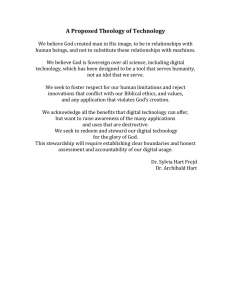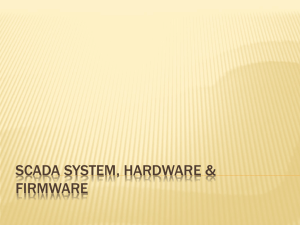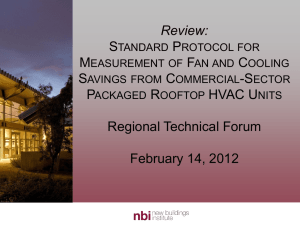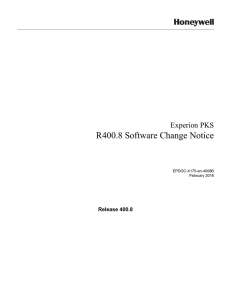RTU2020 Product Information Note
advertisement
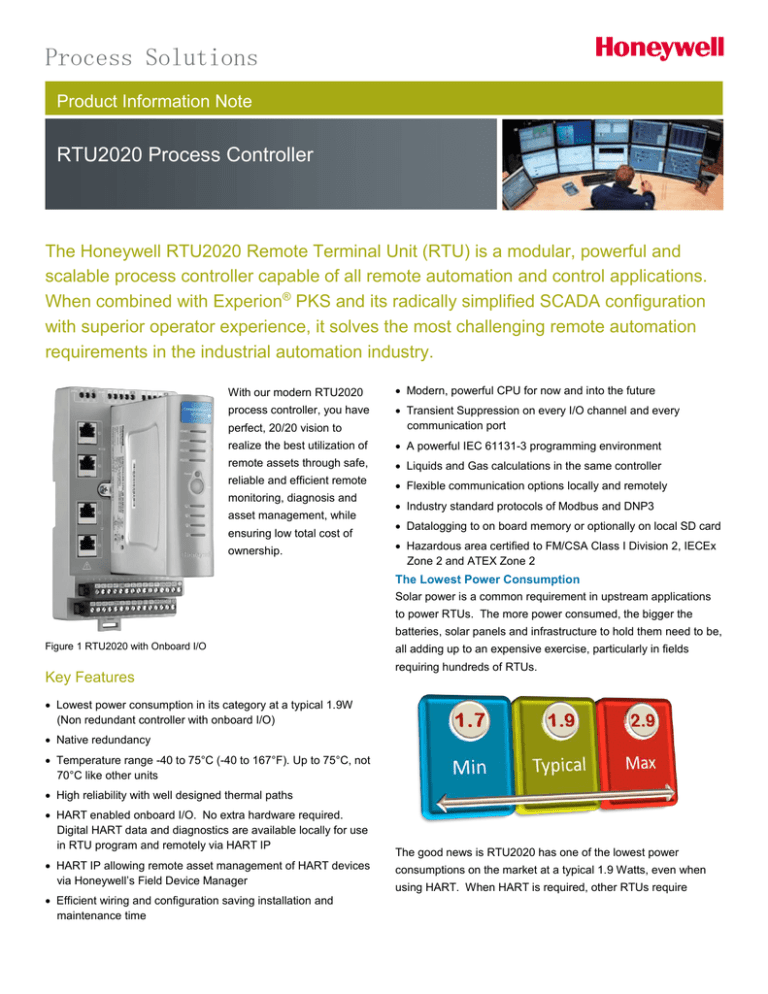
Process Solutions Product Information Note RTU2020 Process Controller The Honeywell RTU2020 Remote Terminal Unit (RTU) is a modular, powerful and scalable process controller capable of all remote automation and control applications. When combined with Experion® PKS and its radically simplified SCADA configuration with superior operator experience, it solves the most challenging remote automation requirements in the industrial automation industry. With our modern RTU2020 Modern, powerful CPU for now and into the future process controller, you have perfect, 20/20 vision to Transient Suppression on every I/O channel and every communication port realize the best utilization of A powerful IEC 61131-3 programming environment remote assets through safe, Liquids and Gas calculations in the same controller reliable and efficient remote Flexible communication options locally and remotely monitoring, diagnosis and Industry standard protocols of Modbus and DNP3 asset management, while ensuring low total cost of ownership. Datalogging to on board memory or optionally on local SD card Hazardous area certified to FM/CSA Class I Division 2, IECEx Zone 2 and ATEX Zone 2 The Lowest Power Consumption Solar power is a common requirement in upstream applications to power RTUs. The more power consumed, the bigger the batteries, solar panels and infrastructure to hold them need to be, Figure 1 RTU2020 with Onboard I/O Key Features all adding up to an expensive exercise, particularly in fields requiring hundreds of RTUs. Lowest power consumption in its category at a typical 1.9W (Non redundant controller with onboard I/O) Native redundancy Temperature range -40 to 75°C (-40 to 167°F). Up to 75°C, not 70°C like other units High reliability with well designed thermal paths HART enabled onboard I/O. No extra hardware required. Digital HART data and diagnostics are available locally for use in RTU program and remotely via HART IP HART IP allowing remote asset management of HART devices via Honeywell’s Field Device Manager Efficient wiring and configuration saving installation and maintenance time The good news is RTU2020 has one of the lowest power consumptions on the market at a typical 1.9 Watts, even when using HART. When HART is required, other RTUs require RTU2020 Process Controller 2 additional hardware, consuming even more power, whereas only a large operating expense, but is also unsafe —and that is RTU2020 has HART onboard. just the trip to site. The traditional RTU strengths of data logging The follow on effect of consuming less power is that there is less heat produced. This, coupled with an aluminium body and well designed thermal paths, means RTU2020 has less component stress which equates to higher reliability. Even in tropical and desert environments, either minimal or no cooling is required. and good sub-system communications with local devices, alongside smart device integration with HART, is enabling better fault modeling, both direct on the RTUs and at central locations. This means that each Field Operator is much more productive and can manage more remote sites than without the implementation of RTU2020. Endures Tough Environments RTU2020 has been designed to withstand the toughest environments, with an operating temperature range of -40 to 75°C in humidity of 5% to 95%. Most other RTUs only go up to 70°C. RTU2020 has conformal coating to G3 and is hazardous area certified to FM/CSA Class I Division 2, IECEx Zone 2 and ATEX Zone 2. 70 75°C RTUs are typically placed next to metal infrastructure such as Figure 2, HART data accessed by RTU and remotely pipelines, so to reduce risk of transient surges, every I/O channel and every communication port on RTU2020 has transient In figure 2, we show RTU2020 accessing both the HART device’s suppression. digitally accurate secondary variable and its diagnostic data. High Performance RTU with HART enabled I/O With a modern dual core 667MHz processor, RTU2020 has the power for today’s applications and spare reserve to meet After receiving a common alarm from the RTU, the operator might go to a dynamically scanned detail page to diagnose the fault further or optionally use Honeywell’s Field Device Manager tomorrow’s needs. RTU2020 comes with non-redundant RTU to connect through to the HART device using HART IP. with 28 onboard I/O, Redundant RTU plus expansion I/O can be For more information on smart device management, refer to the added. Field Device Manager (FDM) PIN. Both the onboard I/O and the Mixed I/O (28) Module comes in this mix: Analog Inputs: 8 Analog Outputs: 2 Digital Inputs: 10 Digital Outputs: 6 Pulse Inputs: 2 Importantly, by having built-in HART, RTU2020 has no requirement for separate expensive and power consuming HART I/O modules or third party components. The Value of HART Distributed operations can require crews of field operators that travel each day over long distances and dangerous terrain. RTU2020 can help bring that requirement to an end. It is not Figure 3, RTU2020 non redundant controller with expansion I/O RTU2020 Process Controller 3 Efficient Wiring and Assembly Native Redundancy Wiring built-in terminals can be a frustrating and error prone Honeywell’s redundancy is ready to go. There is no need to exercise for an installer. To combat this, RTU2020 comes with program any differently from a non-redundant controller. removable field terminals allowing the installer to hold the RTU2020 takes away the complexity. No additional infrastructure terminals in their hand for wiring even with gloves on. In addition, is required to synchronize the data between CPUs and to the terminals are printed with the I/O type and number giving the connect with I/O modules. installer positive identification of the terminal against the ferrule label. Combined, this saves upfront installation cost and reduces wiring errors. Figure 6, Redundant controller with two expansion I/O modules Flexible Communication Ports, Standard Protocols Two features that really differentiate RTUs from PLCs are their communications capability and with that, data logging and history backfill. RTUs need to efficiently manage unreliable, low bandwidth networks. They need to communicate as a slave device to a remote SCADA system, sometimes over a redundant link on two different mediums; but also as a master to local subsystems like gas chromatographs and smart drives. In a “store and forward” type strategy, if communications to SCADA are interrupted, then the RTU needs to buffer data. Once communications is restored, then history is backfilled to SCADA. RTU2020 covers all the scenarios by supporting SCADA Figure 4, Positive identification on removable terminals protocols such as Modbus and DNP3 over: Figure 5, RTU2020 Processor ease of removal from IOTA Two/Four Ethernet ports Two RS-232 serial ports Smart ISA100 Wireless Device Integration RTU2020 comes with an onboard Wireless I/O solution to connect ISA100 wireless devices. These wireless devices appear as native I/O, as if they were hard-wired to the controller. They are programmed and managed with the same configuration tool. Two RS-485 serial ports With DNP3, history recovery back to Experion is natively supported. To allow this backfill to be ‘tuned’ to the available network bandwidth, analog input deadbands can be adjusted remotely from Experion. So, you benefit from the same smart device capabilities as wired Robust Data Logging Ensures Data Availability smart devices. RTU2020 comes with data logging capabilities to record values to data files in flash memory or the onboard SD card, (optional), supporting up to a massive 32GB of data. This ensures important data is never lost and is available for future analysis. The data files can be retrieved remotely through RTU Builder and then displayed or imported by many Windows applications. RTU2020 Process Controller 4 RTU2020 can log data continuously at a pre-defined interval, or Remote Diagnosis data logging can be event-triggered. Just as important as being able to remotely program and upgrade RTU2020 is being able to remotely diagnose the health of the RTU. RTU Builder provides a high definition analysis of the health scenario, leading to fewer site visits. Figure 7, RTU Builder, an IEC 61131-3 Environment RTU Builder ― An Integrated Configuration Environment RTU Builder is RTU2020’s integrated configuration tool to design, configure, program and maintain your RTU investment. RTU Builder is fully compliant to IEC 61131-3 supporting all five programming languages. Ladder Diagram (LD) Function Block Diagram (FBD) Structured Text (ST) Figure 8, Experion Equipment Templates Experion and RTU2020 Instruction List (IL) Through use of open protocols, RTU2020 is designed to work Sequential Function Chart (SFC) with any SCADA system. When combined with Experion, it is the In addition to the basic function blocks that come with an IEC 61131-3 environment, RTU Builder includes Honeywell designed function blocks derived from our extensive industry experience and family of market leading automation controllers. Function blocks include PID, Device Control, Auto Manual, Fan Out, Ratio perfect solution ― the 20/20 solution. With support for up to 5,000 RTUs per server and further server based expansion through the patented Distributed System Architecture (DSA™), Experion is a highly scalable system with the highest level of reliability, safety and security. Control, Position Proportional, Totaliser and AGA/API/IEC gas Experion provides radically simplified SCADA configuration and and liquids calculations, just to name just a few. There are also superior operator and pipeline controller experience through the RTU2020 specific function blocks such as HART Command 3, template based Equipment concept. Experion can be configured ‘read dynamic variables’ and HART Command 48, ‘read and operated by ‘equipment’ like a gas wellhead or a pumping diagnostics status’. station rather than merely points. When you match an Experion RTU Builder is designed to work locally or remotely to the RTUs using TCP/IP. Personnel can program on site or from a remote central location to save time and mitigate the need for site works. Remote Firmware Upgrades Being able to remotely upgrade RTU and wireless device firmware is very important when there are hundreds of RTUs geographically distributed. To account for low bandwidth, unreliable networks, remote firmware upgrading from RTU Builder is a two step process ensuring uptime of the RTU and reliability of the result. Equipment template with an RTU2020 replicated RTU, the cost of configuring the full solution is simplified ever further. Experion and RTU2020 have been designed to solve remote automation requirements in the oil and gas, mining, water and other industries. RTU2020 Process Controller 5 Figure 9, Experion Equipment Display For more information, refer to the Experion SCADA PIN. For More Information Learn more about RTU2020 Process Controller at our website www.honeywellprocess.com or contact your Honeywell account manager. Honeywell Process Solutions Honeywell 1250 West Sam Houston Parkway South Houston, TX 77042 Honeywell House, Arlington Business Park Bracknell, Berkshire, England RG12 1EB UK Shanghai City Centre, 100 Junyi Road Shanghai, China 20051 www.honeywellprocess.com Experion® is a registered trademark of Honeywell International Inc. DSA™ is a trademark of Honeywell International Inc. PN-13-53-ENG November 2015 © 2015 Honeywell International Inc.
